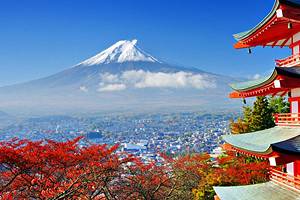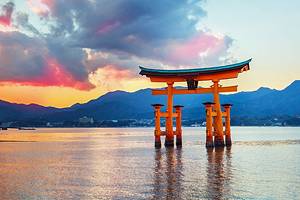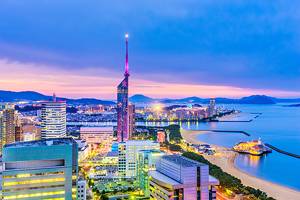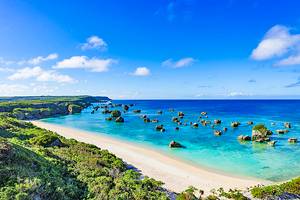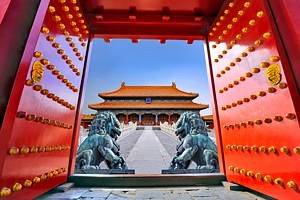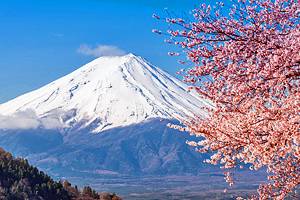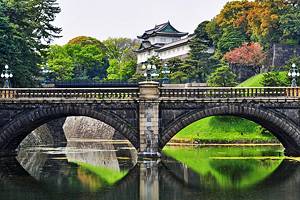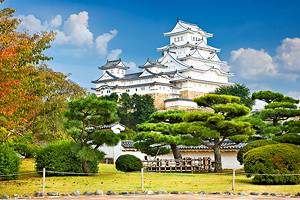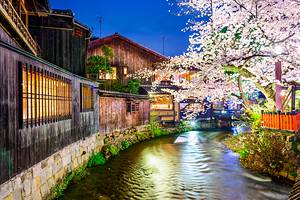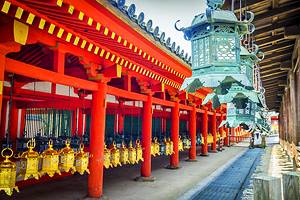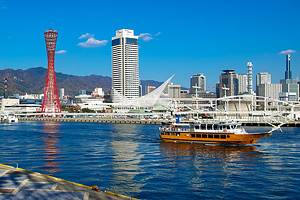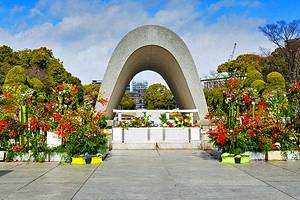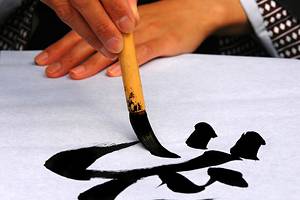Japan in Pictures: Beautiful Places to Photograph
Japan might bring to mind the futuristic streets and giant skyscrapers of Tokyo, but this ancient country is full of unique natural beauty you won't find anywhere else in the world – in fact, 70 percent of the country is covered in forested mountains, mangrove jungles, and imposing volcanoes. Photographers can find an incredible selection of subjects.
From bamboo forests out of a fairy tale and incredible red and gold temples to the beauty of snowcapped Mount Fuji, Japan is full of unexpected beauty ready to be captured by a camera.
- Arashiyama Bamboo Grove, Kyoto
- Takachiho Gorge, Miyazaki
- Shirakawa-go Village
- Gardens of the Imperial Palace, Tokyo
- Tateyama Kurobe Alpine Route
- Gokayama, Toyama
- Kinkaku-ji (Golden Pavilion), Kyoto
- Mount Yoshino, Nara
- Blue Pond, Hokkaido
- Mount Fuji
- Motonosumi-inari Shrine, Yamaguchi
- Miyako-jima, Okinawa
- Miyajima Island
- Kumano Nachi Taisha Shrine and Nachi Falls, Wakayama Prefecture
- Jigokudani Snow Monkey Park
- Gion Geisha District, Kyoto
- Oyama Rice Terraces, Kamogawa
- Lake Kussharo, Hokkaido
- Kiyotsu Gorge Tunnel, Niigata
- Meguro River, Tokyo
Arashiyama Bamboo Grove, Kyoto

The paths inside this stunning forest are flanked by thousands of soaring stalks of bamboo. The path is about 500 meters long and ends (or starts) at the Tenryu-ji Temple, one of the most beautiful Zen temples in Kyoto. The forest is particularly striking in winter, when it's covered in snow.
- Read More: Tourist Attractions in Kyoto
Takachiho Gorge, Miyazaki

The 17-meter-high Minainotaki waterfall is one of the most impressive views along the Takachiho gorge. Photographers can rent a boat to row their way down the gorge and admire the massive volcanic basalt cliffs and lush greenery from up close. There are also trails running alongside the top of the gorge for a different-but equally-breathtaking view.
Shirakawa-go Village

During spring, this historical village turns pink as the sakura cherry blossoms come into bloom. A UNESCO World Heritage Site, the Shirakawa-go Village is made up of houses built using traditional Japanese architecture: rafters and crossbeams that support a slanting thatched roof. The farmhouses in the village are set on small terraces and surrounded by forested hills.
Gardens of the Imperial Palace, Tokyo

Stone and iron bridges cross over the moat to connect the palace buildings with the gardens and streets around. The Tokyo Imperial Palace has been the official home of the Emperor of Japan since the late 19th century. Visitors are only allowed to enter the inner palace grounds twice a year, right after New Year's and on the Emperor's birthday.
- Read More: Tourist Attractions in Tokyo
Tateyama Kurobe Alpine Route

The Kurobe Dam is part of Japan's very popular Alpine Route, also known as the "Roof of Japan." The route, which can be seen from the air but also traveled via land, crosses over the Japanese Alps mountain range, including Mt. Tateyama. The mountain is part of Japan's "Three Holy Mountains," which also include Mt. Fuji.
Gokayama, Toyama

This UNESCO World Heritage List village features traditional houses – many over 300 years old – in a rural mountain environment. The homes in this small village have gassho roofs (a thatched, sloped roof), which have to be replaced every 15 years. In winter, the village receives meters of snow and becomes a winter wonderland that attracts many tourists.
Kinkaku-ji (Golden Pavilion), Kyoto

The Golden Pavilion sits on a pond in the Rokuon-ji temple complex. Designated as a National Special Historic Site, the gold-leaf covered pavilion occupies center stage among gardens, peaceful bridges crossing over serene waters, and an overall design meant to promote perfect harmony between heaven and earth.
Accommodation: Places to Stay in Kyoto
Mount Yoshino, Nara

Sakura (cherry blossom) flowers cover Mount Yoshino in spring, attracting many visitors. A number of important shrines – including Yoshino Mikumari, a Shinto shrine dating back to the early 1600s – are located around the base of the mountain, and the entire mountain has been designated a UNESCO World Heritage Site.
- Read More: Tourist Attractions in Nara
Blue Pond, Hokkaido

The blue waters of this man-made pond are due to the presence of colloidal aluminum hydroxide. The pond was accidentally created when a dam was built. The dam was set up to contain some of the mudflows that would have otherwise affected the town of Biei after the eruption of Mount Tokachi. The blues are at their brightest in spring and fall. This is the perfect place to create striking images.
Mount Fuji

One of the most beautiful views of Mt. Fuji can be seen as it reflects on Lake Kawaguchiko, a popular resort area in both winter and summer. Mt. Fuji, the highest volcano in Japan, remains covered in snow for about half of the year – a postcard-perfect background and one of the most visited and photographed places to visit in Japan.
- Read More: Exploring Mount Fuji: A Visitor's Guide
Motonosumi-inari Shrine, Yamaguchi

The shrine's 123 red torii gates lead visitors straight to a steep cliff and magical azure views over the Japan seas. The view is especially striking when the sun sets, with reds and yellows snaking through the sky.
At the top of the hill, the shrine itself consists of a series of small buildings and a saisenbako (offertory box) five meters up in the air, where visitors can try throwing coins while making a wish – if the coin falls into the box, the wish will come true.
Miyako-jima, Okinawa

Turquoise waters surround this cliffy island covered in sugar cane fields and pristine white beaches. A popular snorkeling destination and often considered one of the most beautiful destinations in Japan, the island attracts many visitors. The lighthouse at the end of the cape is a much-loved spot for sunrise viewing.
Miyajima Island

Miyajima island is a beauty in itself, but it's best known for being home to the stunning torii (gate) of Itsukushima Shrine, which is partially submerged in water. Toriis are meant to represent a way to cross from the mundane to the sacred when entering the grounds of a shrine. This shrine is dedicated to the deities that govern over the seas and storms.
Kumano Nachi Taisha Shrine and Nachi Falls, Wakayama Prefecture

Nachi, the tallest waterfall in Japan, is the perfect background for this shrine, one of the most beloved pilgrimage routes surrounded by lush evergreen and moss-covered trails. It's also a great place for pictures. The Nachi Matsuri Fire Festival is held here every year, when torch-bearers climb the stone staircases carrying giant flaming beacons.
Jigokudani Snow Monkey Park

Wild Japanese macaques take advantage of the hot springs inside Joshinetsu Kogen National Park during winter, when heavy snowfall covers the park for up to four months a year, and temperatures plummet. Since there's no source of food for them in the area, the macaques are fed by park rangers and have become used to human presence – a good thing since visitors come here from all over the country to photograph them.
Gion Geisha District, Kyoto

Kyoto's most historic and iconic district is particularly famous as a geisha district, but its beauty goes well beyond that. Machiya (old-style wooden Japanese houses) line up the pedestrian streets here, and historical temples, cherry tree-lined alleyways, and ochaya (teahouses) add to the charm.
Oyama Rice Terraces, Kamogawa

Easily accessible from Tokyo, the Oyama rice paddies – made up of almost 400 terraces – are breathtakingly beautiful at any time of year. For the best photographs, arrive after a heavy rain to see the terraces transform into giant mirrors of greens and blues. Arrive at dawn to catch the sun rising just over the terraces in the distance.
Lake Kussharo, Hokkaido

Japan's largest volcanic crater lake is part of the migratory path of swans and is surrounded by thermal springs and a beach with naturally heated sand. In winter, the contrast of the snowy peaks in the background with the steamy waters provides the perfect scenery for photographs. For those with a sense of adventure, it's possible to kayak the lake or bike the paths around it.
Kiyotsu Gorge Tunnel, Niigata

Surrounded by towering volcanic cliffs and particularly stunning autumn colors, the beauty of this gorge is best appreciated through the Light Cave or Kiyotsu Tunnel. Over 750 meters long, the tunnel offers four viewpoints along the length of the gorge – but it is its design, complete with massive mirrors that transform the space into a living environment that make the place truly magical.
Meguro River, Tokyo

While Meguro River is almost eight kilometers long, it's the section that crosses through central Tokyo that's made the waterway famous. Over 800 cherry trees line up the river here. During spring, when the trees are in bloom and illuminated by thousands of tiny golden lights, this spot in the river becomes one of the premium places to see cherry blossoms in the capital city.


